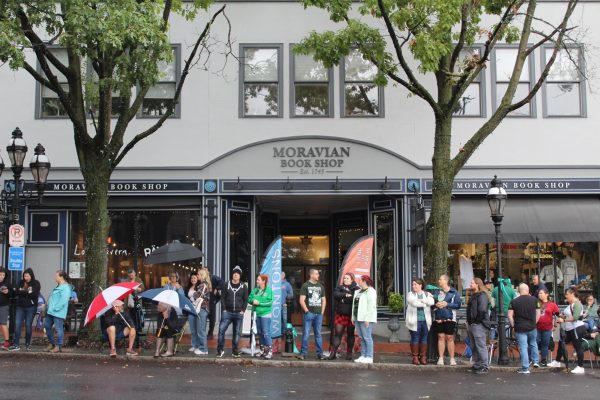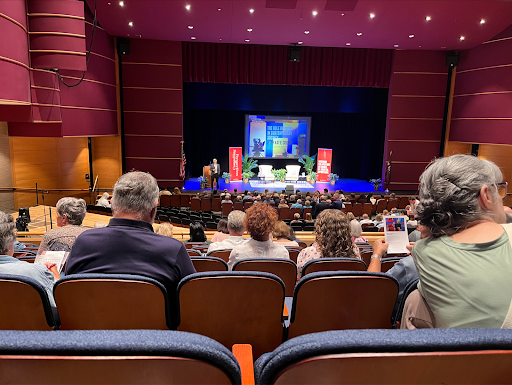Reconciling History: The Moravians’ History with the Lenape
Jack Johnson, an enrolled member of the Delaware Nation, a federally-recognized indigenous tribe based in Oklahoma, spoke with Moravian students and staff via Zoom on Friday, Feb. 4, where he discussed the history of the Lenape Tribe and the Moravians.
Hosted by Moravian University’s Office for Diversity, Equity, and Inclusion, the hour-long event featured a talk by Johnson and a Q&A session where viewers were able to pose questions.
The event began with an introduction by Christopher Hunt, Vice President and Dean for Equity and Inclusion, and Dr. Jamie Paxton.
Paxton began with a land acknowledgement, recognizing that the greater Lehigh Valley and Moravian University was built on land once belonging to the Lenape Tribe.
Johnson said the land acknowledgement meant a lot, that other universities and institutions have begun to adopt it, and that it showed respect to the Native Americans who were here before the European settlers.
The Lenape, who are more commonly known today as the Delawares, were the first indigenous tribe to meet the Europeans in the early 17th century. The Lenape traded furs for European-made goods.
“[The Moravians] had a mission,” Johnson said. “To come there to Christianize so-called heathens, so-called savages.”
The Moravians first arrived in this country in Savannah, GA, where they met resistance from the Cherokees, before moving north to Pennsylvania. The Delaware, who had previously encountered and traded with Europeans, trusted the Moravians
“The Moravians treated the Native Americans as equals,” Johnson said. “They did not attempt to exploit them and for those who wanted to become Christians, the Moravians were there to help.”
Many Delawares converted to Christianity thanks to the teachings of the Moravians.
According to Johnson, the Moravians taught the Delaware skills to succeed as Christians, but this forced the Delaware to abandon many of their traditions. In return, the Delaware showed the Moravians how to live off the land. A major part of the Delwares’ responsibilities was farming, taking care of livestock, hunting, and getting food.
“[The Moravians] insisted upon maintaining a division of labor in which the converts were the laborers and they were the elites,” Johnson said.
Around the time of the American Revolution, the British and American colonists were suspicious of the pacifist Moravians. A group of American militiamen rode out from Fort Pitt in western Pennsylvania and found the converted Delaware. Since the Delaware had adopted Moravian ideals, they saw the militiamen as allies.
“[The militiamen] told them, ‘Come with us, we’ll protect you,’” Johnson said. “And, of course, [the Delaware] believed them.”

The militiamen took a vote on whether to spare or kill the Delaware, and the latter was chosen. After the colonists told the Delaware that they were going to kill them, the Delaware prayed, and the next day, the Delaware converts were clubbed to death, including men, women, and children, in an event called the Gnadenhutten Massacre.
“The Moravian and the Delaware relationship didn’t end well for the Delawares,” Johnson said. “The Moravians were teaching and showing the Delawares that you live like us, you dress like us, and that you’ll be protected. They were killed by people that they trusted.”
“Getting to learn about the relationship between the Lenape and Moravian missionaries from someone who is a member of the Delaware Nation was a meaningful experience,” English major Amanda Whitworth, ‘22, said. “Hearing it, rather than reading it, really puts into perspective the ways in which historical events carry into the present. As students of Moravian University, I feel that we are encouraged to cultivate an identity connected to Bethlehem’s Moravian past. But I think in order to move toward a more ethical use of this land, it is necessary to consider the area’s past from other points of view, and to recognize all of the layers of cultural history that exist here.”
“It is important for Moravian students, professors, and staff to recognize the history between the Moravians and the Delaware Nation since we benefit from the dispossession of Lenape land,” Alyssa Dlutz, ‘22 a Political Science and History major, said. “We all learn, study, work, etc., on land that was stolen from Natives due to the fraudulent Walking Purchase. While all of us who currently study and work at Moravian did not force them to migrate westward, we still should be acknowledging this past in order to create a better future.”







